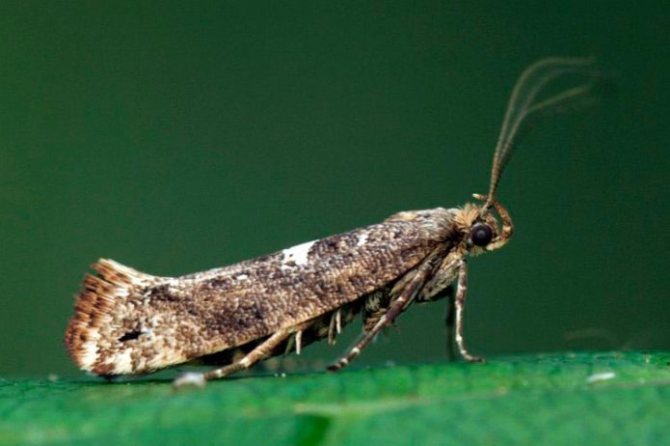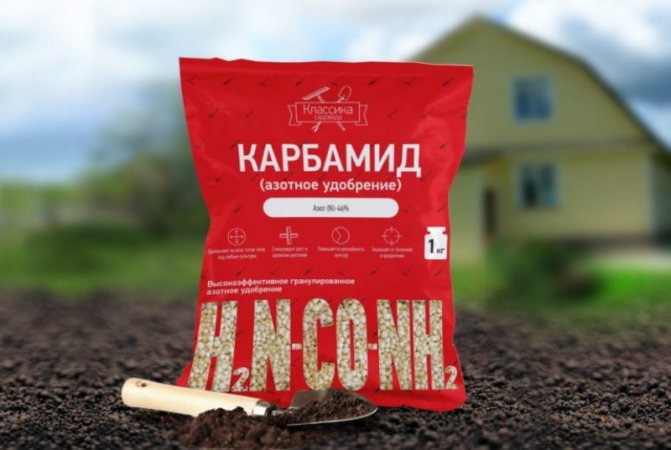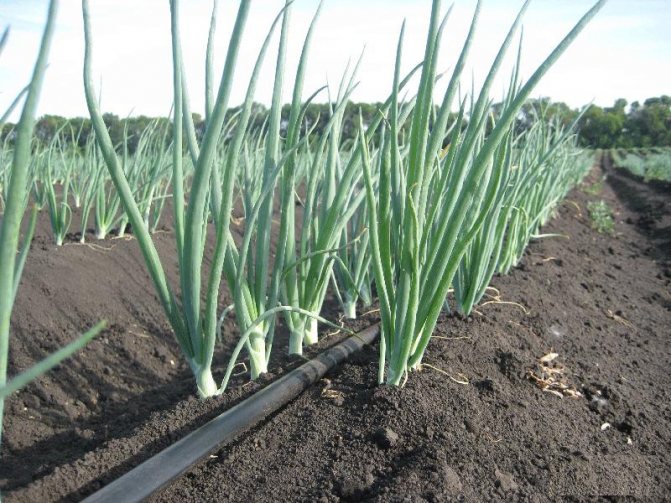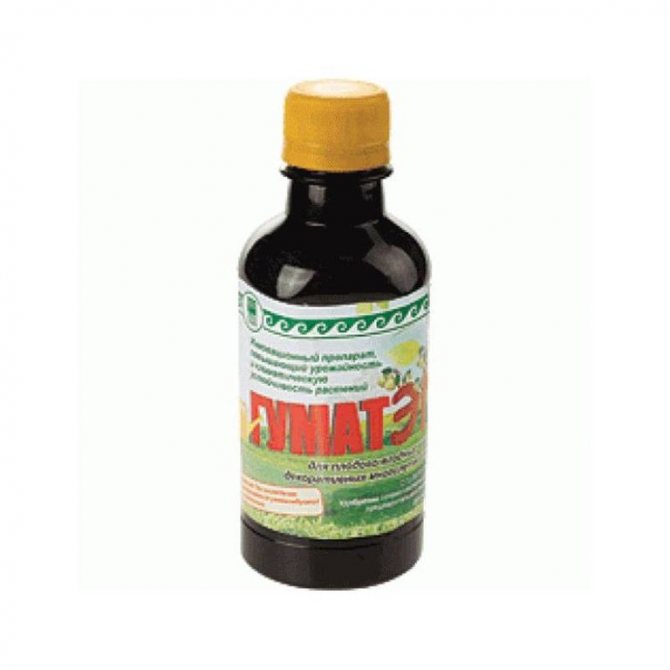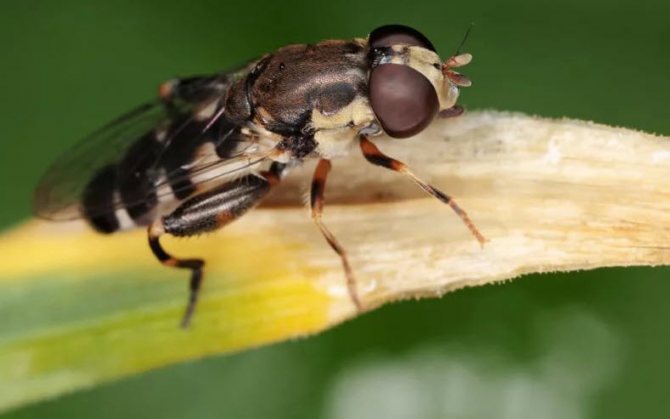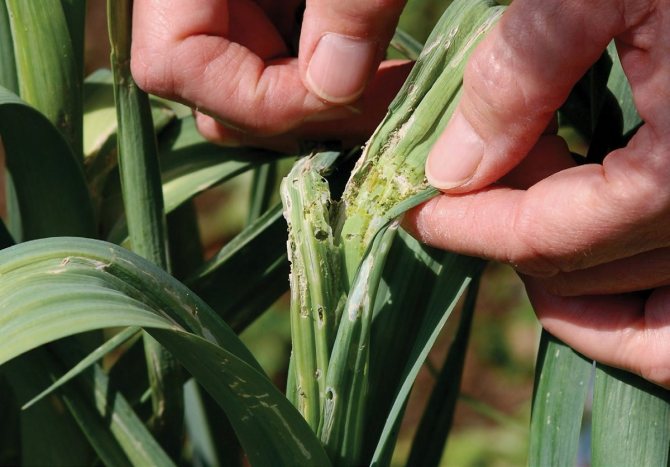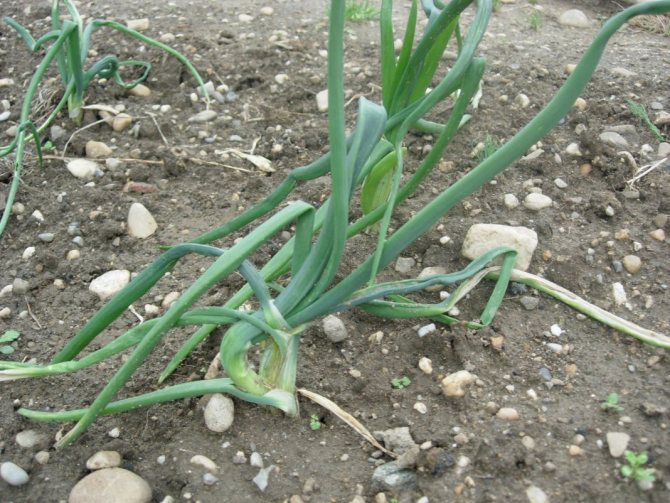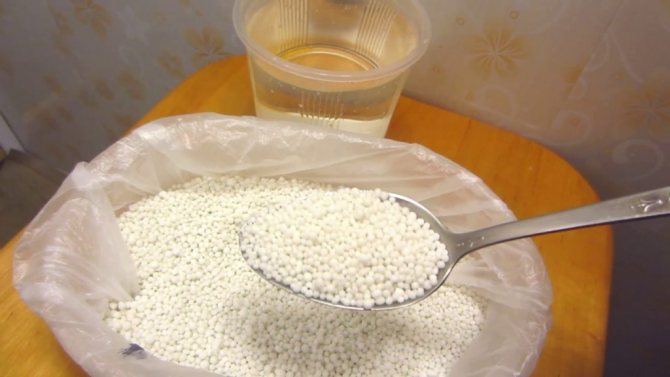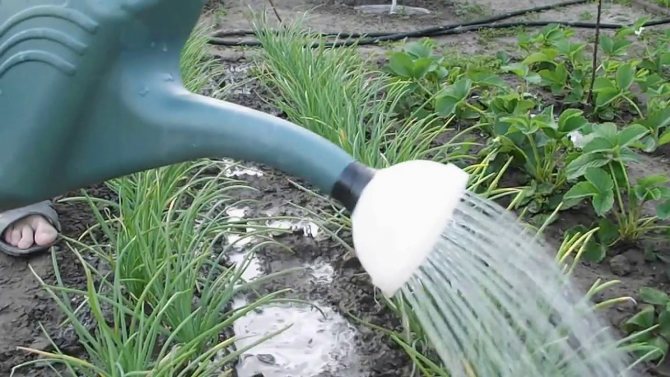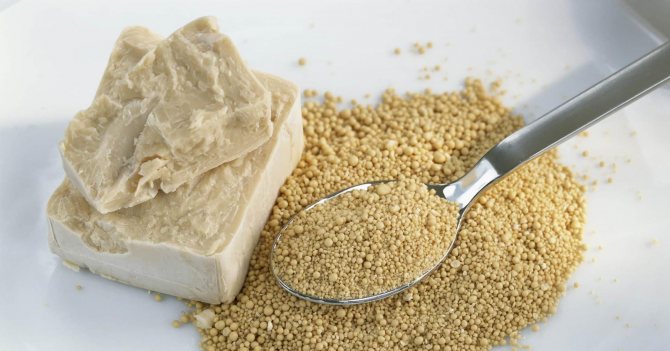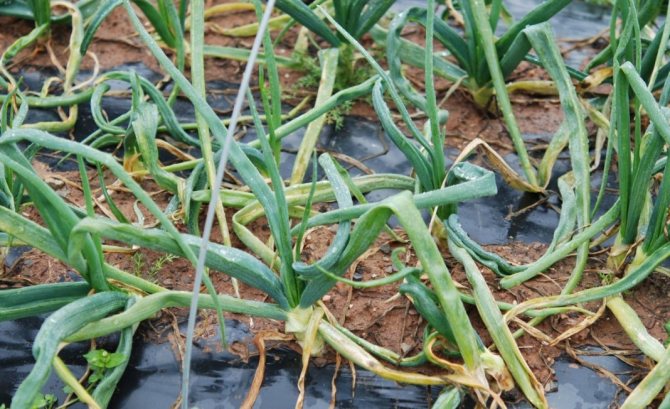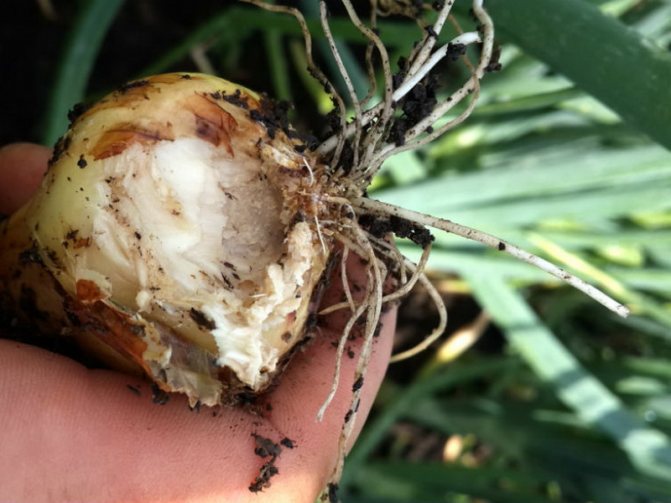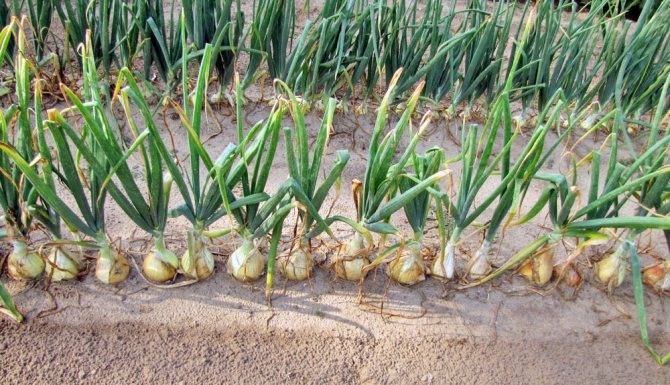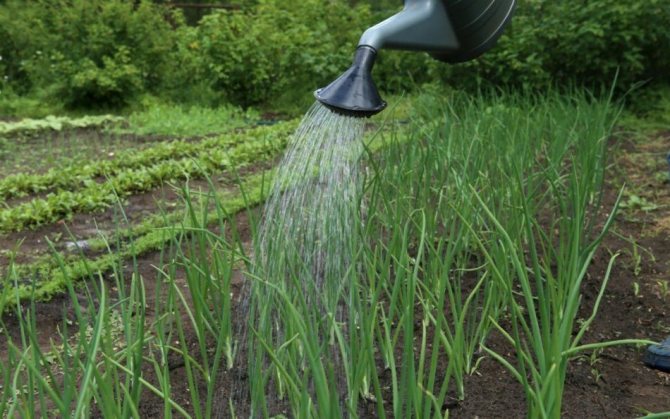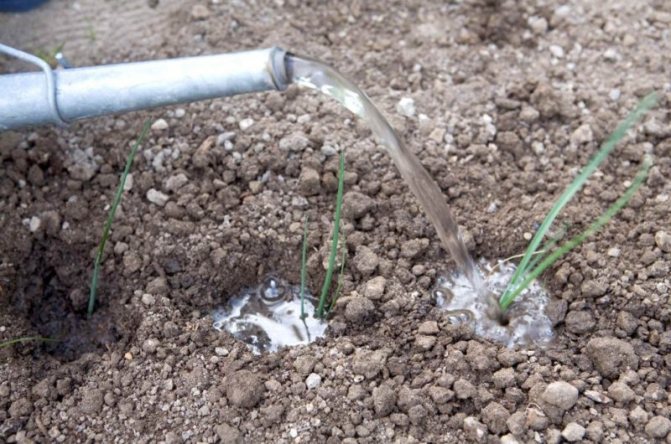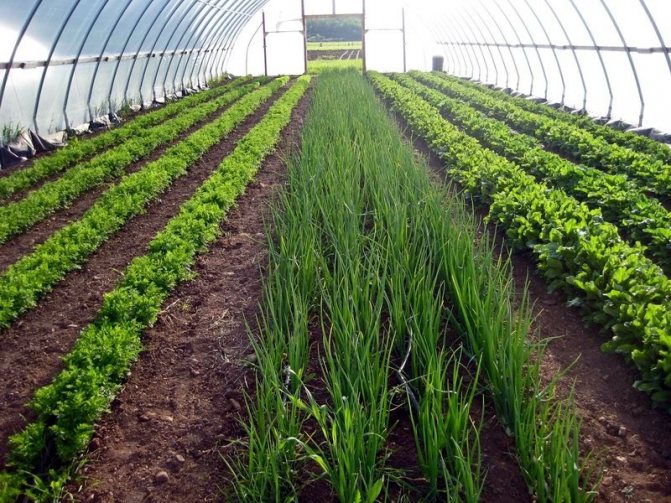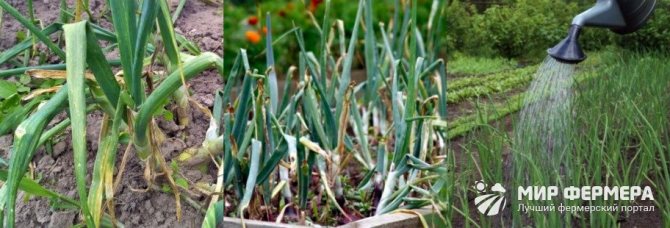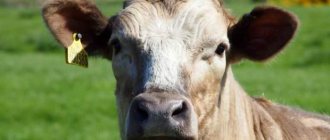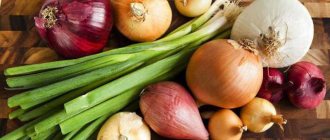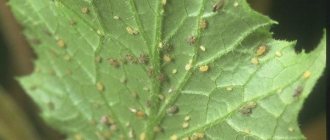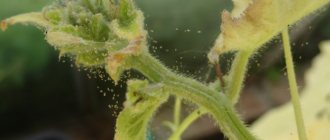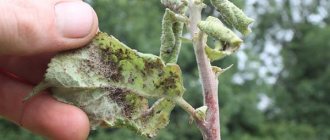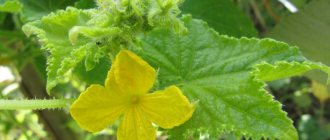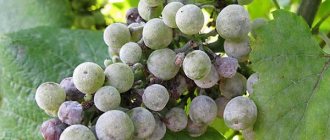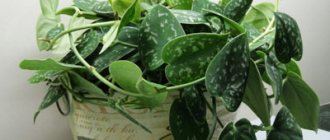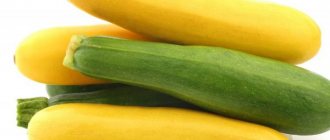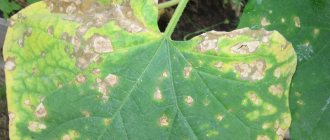Vegetable growing »Onion
0
11422
Article rating
Many gardeners, especially those who are just starting to produce food, ask themselves a completely logical question: what to do so that the onion does not turn yellow? How can the current situation be corrected in the shortest possible time?
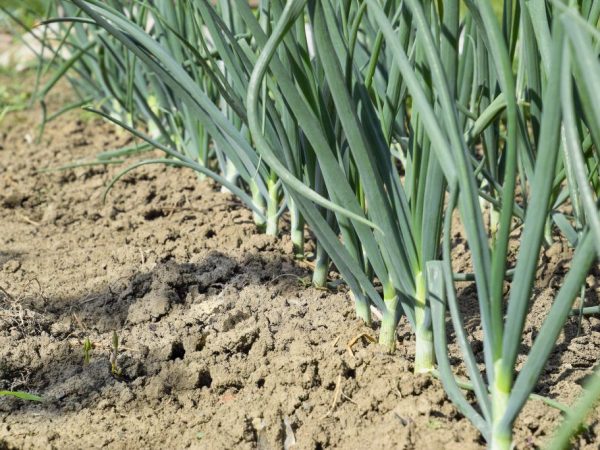
Why does the onion turn yellow
Many diseases of garden crops, including onions, are subject to this ailment. Yellowing is not temporary. And if you do not pay enough attention to such symptoms, you can ruin the entire crop.
Why onions turn yellow - the main reasons
The ground part of onions in everyday life is called feathers, and the underground part is called a turnip. Leaves help the plant store nutrients. They begin to turn yellow and dry by the end of July - early August, signaling the gardener to prepare for harvesting.
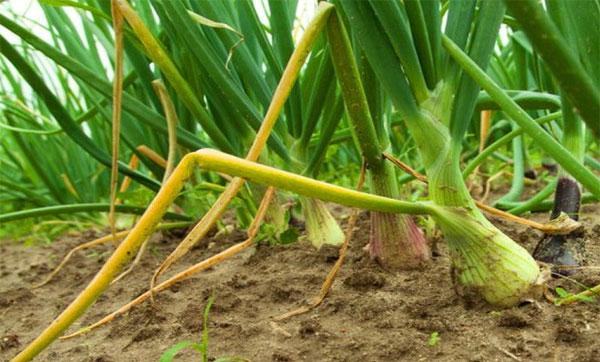

If the ground part begins to fall, turns yellow, the onion "lays down", and it is too early to pull it out of the ground, it is necessary to figure out what can cause a change in the color of the leaves.
The feather turns yellow from the following reasons:
- plant diseases;
- pests;
- insufficient content of nutrients in the earth;
- improper onion care;
- adverse weather conditions.
Diseases of the onion plant
If the onion turns yellow, it is quite possible that the development of some kind of disease manifests itself in this way, and there are a lot inherent in this plant culture. The most common diseases are bacterial rot, rust, etc.
These diseases are caused by bacteria and fungi, which can spread through poor-quality planting material, so the first thing to do is to prevent pests from breeding, it will be enough to carry out simple preventive actions. The sevok must be sorted out and the spoiled bulbs must be eliminated from the total mass.
There is a nuance regarding decorative onions: during the cultivation of this variety, so that it does not turn yellow or be stained, all the specified processing methods must be used.
Onions that turn yellow in the sun can be considered healthy as well, but only when they are harvested and dried for storage. In all other cases, if observed:
- instead of green, a yellow feather;
- leaves fall to the ground;
- the tips of the feathers turn yellow -
an onion plant needs careful care. In order not to establish the reason why the yellowing began, the problem must be nipped in the bud. For this, proper care of the site and the plant is sufficient. Do not forget that it needs to be fed on time for better growth.
Pests and the fight against them
Garden pests can also cause leaves to turn yellow and dry. Insects on an onion bed are small in size, but can easily deprive the owner of the crop.
Onion moth
Onion moth butterflies reach 0.7 cm in length, have a gray-brown color. They lay eggs at night, remaining unnoticed for a long time. The larvae of these insects hatch from May to September. They feed on onion leaves. Transparent spots are formed, the feather turns yellow. The second generation of moths eat the turnip, causing cervical rot.
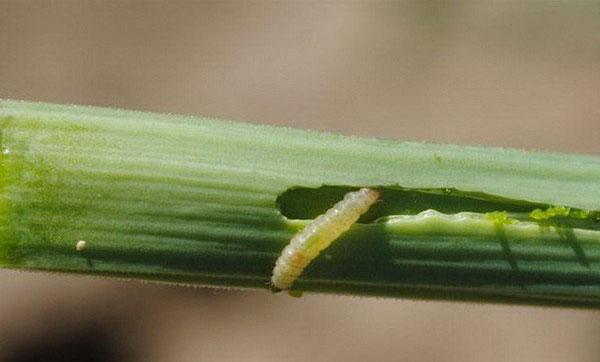

To cope with insects will help:
- the use of crop rotation;
- weeding out diseased plants, loosening;
- weed control, plowing at the end of the season;
- alternation of planting onions with carrots, mustard.
- treatment with an insecticide "Iskra" or a biological product "Summer resident".
Recommended to read
Rules for feeding onions on turnips or greens
Ways to preserve green onions for the winter
How to properly dry onions after harvesting from the garden
What to do if the onion rots during storage and in the garden
Thrips
If the tips of the feathers turn yellow on the onion, it is necessary to inspect the plants for damage by thrips. In the axils of the leaves, you can see lesions resembling silver specks and a little later black dots, and sometimes the very small light brown elongated insects.
The damaged feather becomes more susceptible to other infections and dries up. Thrips not only suck the juice from the leaves, but also lead to cosmetic damage to the neck and scales of the bulb. Favorable conditions for breeding:
- no weeding;
- dry air and earth in the garden.
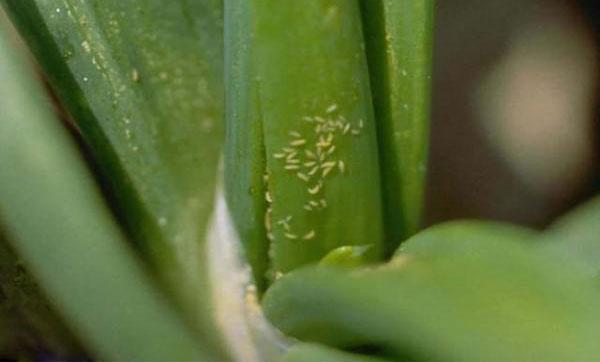

Thrips hibernate in the surface layer of the soil, on the left tops, bulbs, so the fight against them consists in:
- deep plowing of the land;
- ensuring crop rotation;
- laying out sticky traps between rows;
- alternating plantings of onions with repellent plants - calendula, tagetes;
- processing the bulbs before planting by immersing them in hot and cold water for a few minutes;
- regular watering and weeding of beds.
Of the pesticides recommended for use are "Vantex", "Lannat", "Agravertin". The feather should not be eaten after processing.
Onion fly
The onion fly appears in May and lays its eggs close to the ground. The hatched larvae of this insect begin to gnaw the bulb, as a result of which the leaves turn yellow. Having killed one plant, the fly moves on to the next, destroying crops. Surviving landings are weakened and prone to other diseases.
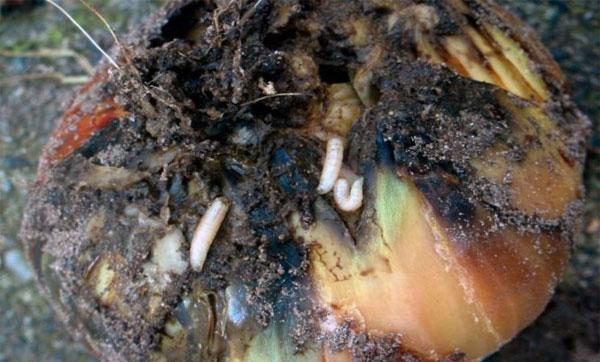

To reduce the number of pests, it is recommended to use insecticide-treated onion planting material. Fly drugs: Lannat, Borey, Alatar.
Stem nematode
Stem nematode is a small worm that enters the garden along with the seed or remains in the ground, on plant debris. The pest enters through the bottom of the turnip or pores on the underside of the leaves. If it affects the planting of sevka, the plants turn yellow and die. With a later reproduction of worms in the tissues of the culture, the leaves turn yellow and bend at the base, the underground part begins to lag behind in growth, becomes covered with a waxy bloom. Such a crop is poorly stored and is more often damaged by other pests than a healthy one.
The contaminated material is destroyed. Carry out pre-sowing treatment of bulbs and seeds before planting: black onions are soaked first in cold water for 3-4 hours, after which they are immersed in hot water at a temperature of about 40 degrees for 10 minutes. The sevok is kept in water with a temperature of 45 degrees for 15 minutes.
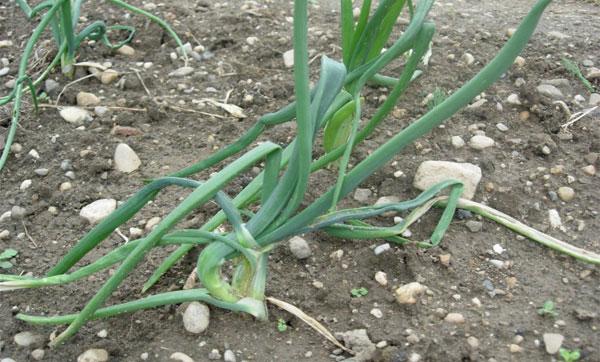

Weevil
Weevil is a small dark-colored beetle. He hibernates in the soil and begins his meal with the bulbs left in the fall, gradually moving to young plants. The footprints of this insect appear as round, whitish, rows of spots on the leaves. The pest inflicts the greatest damage on the seedlings of nigella - plantings of onions in the spring turn yellow and die. Adults lay eggs in leaf cavities. Beetle larvae hatch and begin to gnaw out passages, which look like longitudinal stripes at close range. The feather begins to turn yellow at the top and dries out. Mass death of plants is rare, new leaves grow over the summer, a decrease in the amount of harvest is possible.


If onion feathers begin to turn yellow at the tips, it is necessary to inspect the plantings; when a weevil is found, apply:
- deep plowing of the land before winter;
- spraying with infusions of garlic, red pepper, mustard;
- treatment with a solution of "Karbofos" (unacceptable when growing onions on a feather), "Agravertina", "Fitoverma".
Gardeners' recommendations
Experienced gardeners advise, when yellowing winter onions or perennial ones, pour it with a solution of soda. Add a tablespoon of powder to 10 liters of water. This remedy is versatile and suitable for a wide variety of reasons.
There are also recommendations that do not require special techniques and ingredients, but you need a real well or a spring. When the onion begins to turn yellow, it is immediately watered with cold water from such a source for 2-3 days. It also gives good results.
Many gardeners use the best practices and books of Oktyabrina Ganichkina. She very well described onion diseases and recommendations for solving these problems.
Lack of nutrients in the soil
Onion feathers begin to deteriorate from lack of nutrients. Family onions, which begin to turn yellow when planted on a poor substrate, are considered especially sensitive to the composition of the soil.
Having carefully examined the beds, excluding possible diseases or invasion of pests, the gardener may remember that he did not apply fertilizers in the spring or planting plants for the first time revealed a lack of micro- or macroelements. It is necessary to list exactly which substances in deficiency or excess make the onion turn yellow:
- Manganese deficiency. This trace mineral helps in the formation of the chlorophyll pigment, which gives the leaves a green color. With its lack, yellow stripes form on the leaves, and turnip development slows down. To adjust the manganese content, use manganized superphosphate, ash, manganese sulfate solution.
- Nitrogen deficiency. It is possible to assume a lack of nitrogen in the soil if no other visible reasons for the deterioration of the state of the leaves can be found. In this case, it is imperative to feed the onion so that the onion feathers do not turn yellow. For this, ammonium nitrate is dissolved in water at the rate of 20 g per 6 liters per 1 m2.
- Excess nitrogen. In this case, the bulbs will rot. To save the harvest, they are treated with a solution of potassium sulfate and superphosphate, 1 tsp. by 12 liters per 2 m2, and after a few days the soil is loosened and ash is added.
- Magnesium deficiency also causes a change in the color of the ground part - old leaves begin to turn yellow, the tops turn brown, the feather dries up and dies off. In this case, foliar feeding is necessary, which is carried out by spraying a solution of magnesium sulfate (1 tbsp. L. Substance per 10 liters of water).
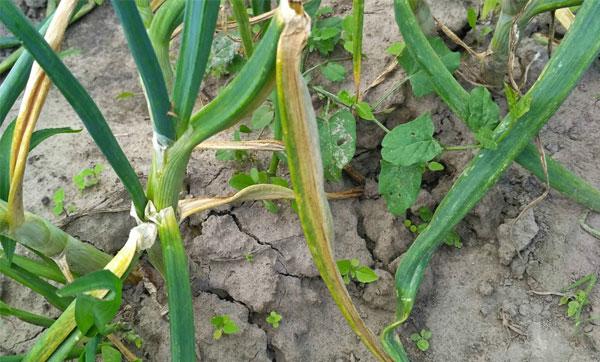

If the family onion turns yellow, ash or a solution of 7 g of potassium salt, 5 g of ammonium nitrate per 6 liters of water per 1 m2 are added to the soil.
Soil acidity
A good harvest of onion greens can only be on fertile black earth. This vegetable crop does not like swampy, poor and heavy soils, and when planting seedlings, it is important to pay attention to the acidity of the soil, which should be neutral (pH7). The best variety of onions for greens - batun, grows only with acidity, whose level does not exceed 7.8 pH.
What if the acidity of the soil is too high and the onion turns yellow from this? It is possible to reduce the acidic environment with the help of additional alkaline agents, which are introduced in advance, a year or two before planting the seedlings. Usually they use:
- slaked lime;
- dolomite flour;
- wood ash.
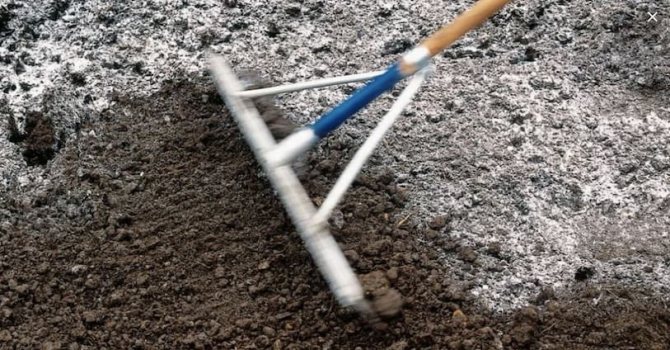

Pretreating the soil with alkalis will help save future onion crops. In the process of preparing the soil, you can additionally enrich it by introducing organic fertilizers for the winter.
Failure to comply with the rules of care
The onions in the garden are sensitive to care. It is enough to disrupt the watering regime, and the plant will begin to signal the deterioration of conditions. In order not to start to turn yellow onion feather, you should adhere to the following rules:
- Pour the onion with water at room temperature.
- When plants begin to release roots, they should be watered abundantly at least 2 times a week.
- Mulching will help save the soil from drying out.
- The best time to water is in the morning or evening.
- Hard water for irrigation is softened by adding a little acetic acid.
- Since June, onions are watered once a week, in July, once every 1.5 weeks.
The watering schedule should be adjusted to the weather conditions: if the summer is dry, hot, then the plants need to be "watered" more often so that the juicy leaves do not start to turn yellow. If it rains frequently, it is better to refuse mulching and periodically loosen the soil.
Weather
Unfavorable weather conditions can cause the onion to turn yellow and “lay down”, even if all other conditions for its growth are met. In heavy rains, the beds are covered with a film, and the soil is sprinkled with a mixture of ash and sand. In the event of a drought, precious moisture can be saved by watering it in the morning and mulching the ground.
If the tips of the onion turn yellow from the fact that recurrent frosts have "walked" on them, no measures should be taken, the feather will grow back over time.
Folk remedies to combat yellowing
The use of folk remedies is based on many years of observation of cultivated plants and pests. Creating a comfortable environment by planting useful "neighbors" and safely killing voracious insects will help preserve the crop without the use of pesticides. In the case of onions, this means that the use of folk remedies allows you to tear it "into a feather" while the onions are poured.
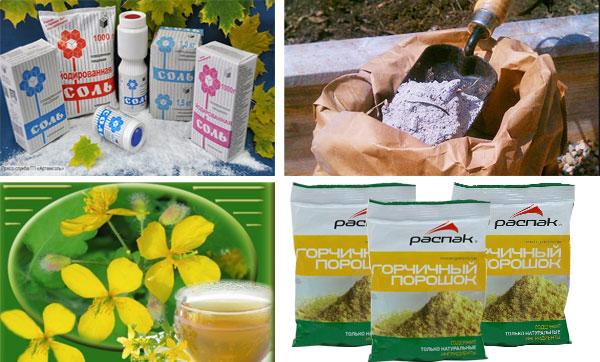

- "Sticking" will protect the seed from the nematode, if, before planting, keep the seed and nigella for 20 minutes in a solution of sodium chloride at the rate of 1 tbsp. l. for 1 liter of water.
- Dusting the plants with a mixture of ash and tobacco will help prevent the feast of the onion fly. And so that the planting does not begin to turn yellow from the invasion of its larvae, gardeners water the onion with the following solution: pour 200 g of tobacco with 2 liters of boiling water, leave for several days, then add 1 tbsp. l. ground red pepper and laundry soap, then add water to a whole bucket.
- To prevent the garden from turning yellow from the onion moth, when the seedlings grow 5 cm, the soil on it is watered with a strong solution of sodium chloride (100 g of sodium chloride per 1 liter of water).
- It is recommended to alternate rows of onions with carrots and marigolds. They dislike harmful insects and the pungent smell of currants, so planting seedlings next to berry bushes is also justified. Legumes "raise" nitrogen to the surface and share it with onions
- To save the crop from rot of the bottom will help the processing of the seedlings before planting in a solution of potassium permanganate. And if the summer turned out to be rainy, the arrangement of drainage in the garden will help.
- From thrips, water the onion with a solution of celandine at the rate of 1 part of dry grass per 10 liters of water.
- The weevil also does not like the salty or bitter taste of onions, so spraying with saturated solutions of salt, pepper, mustard or garlic will chase away the harmful bug before it settles in the garden and the leaves begin to turn yellow.
- When leaves are suffering from a nitrogen deficiency, they can also be helped without resorting to chemicals. To saturate the plants, a fertilizer of the following composition is prepared: vegetable food waste, weeds, hay, cut grass are collected in a barrel, a little sour jam or sugar is added, poured with water, stirred. After a few days, active fermentation will make itself felt with a characteristic unpleasant odor. This product should be diluted with water in a ratio of 1:10 and poured over onions.

